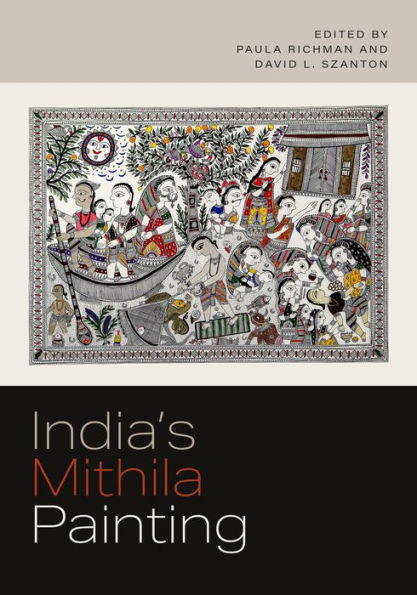India's Mithila Painting
A woman's art form transforms from home to high art
Since at least the fifteenth century, Hindu women in the Mithila region of northern India have been painting images of deities, flora and fauna symbolizing fertility and prosperity, and floor designs that sacralize sites for ritual within their homes. Their artwork remained ephemeral since its plant-based colors faded over time. In response to an extended drought that led to widespread crop failure in the 1960s, the Indian government's All India Handicraft Board provided high-quality paper to the women of Mithila to test the income-generating possibilities of transferring wall and floor artwork to a new medium. The unique Mithila aesthetic, novel compositions, and precise linework won enthusiastic buyers in New Delhi and abroad. The small number of women painters expanded across the ranks of the social hierarchy and even included a few men. They developed individual styles and depicted novel subjects such as village history, their own life stories, the tsunami in Sri Lanka, social justice, protecting trees, and changing social norms.
Major international museums now house Mithila collections, and individuals around the world own paintings. This volume, the first to present an up-to-date analysis of the history and practitioners of Mithila painting, includes contributions from Mithila artists, anthropologists, art historians, historians of Indian religions and specialists of visual culture, gender studies, and translation studies.
1147034380
Since at least the fifteenth century, Hindu women in the Mithila region of northern India have been painting images of deities, flora and fauna symbolizing fertility and prosperity, and floor designs that sacralize sites for ritual within their homes. Their artwork remained ephemeral since its plant-based colors faded over time. In response to an extended drought that led to widespread crop failure in the 1960s, the Indian government's All India Handicraft Board provided high-quality paper to the women of Mithila to test the income-generating possibilities of transferring wall and floor artwork to a new medium. The unique Mithila aesthetic, novel compositions, and precise linework won enthusiastic buyers in New Delhi and abroad. The small number of women painters expanded across the ranks of the social hierarchy and even included a few men. They developed individual styles and depicted novel subjects such as village history, their own life stories, the tsunami in Sri Lanka, social justice, protecting trees, and changing social norms.
Major international museums now house Mithila collections, and individuals around the world own paintings. This volume, the first to present an up-to-date analysis of the history and practitioners of Mithila painting, includes contributions from Mithila artists, anthropologists, art historians, historians of Indian religions and specialists of visual culture, gender studies, and translation studies.
India's Mithila Painting
A woman's art form transforms from home to high art
Since at least the fifteenth century, Hindu women in the Mithila region of northern India have been painting images of deities, flora and fauna symbolizing fertility and prosperity, and floor designs that sacralize sites for ritual within their homes. Their artwork remained ephemeral since its plant-based colors faded over time. In response to an extended drought that led to widespread crop failure in the 1960s, the Indian government's All India Handicraft Board provided high-quality paper to the women of Mithila to test the income-generating possibilities of transferring wall and floor artwork to a new medium. The unique Mithila aesthetic, novel compositions, and precise linework won enthusiastic buyers in New Delhi and abroad. The small number of women painters expanded across the ranks of the social hierarchy and even included a few men. They developed individual styles and depicted novel subjects such as village history, their own life stories, the tsunami in Sri Lanka, social justice, protecting trees, and changing social norms.
Major international museums now house Mithila collections, and individuals around the world own paintings. This volume, the first to present an up-to-date analysis of the history and practitioners of Mithila painting, includes contributions from Mithila artists, anthropologists, art historians, historians of Indian religions and specialists of visual culture, gender studies, and translation studies.
Since at least the fifteenth century, Hindu women in the Mithila region of northern India have been painting images of deities, flora and fauna symbolizing fertility and prosperity, and floor designs that sacralize sites for ritual within their homes. Their artwork remained ephemeral since its plant-based colors faded over time. In response to an extended drought that led to widespread crop failure in the 1960s, the Indian government's All India Handicraft Board provided high-quality paper to the women of Mithila to test the income-generating possibilities of transferring wall and floor artwork to a new medium. The unique Mithila aesthetic, novel compositions, and precise linework won enthusiastic buyers in New Delhi and abroad. The small number of women painters expanded across the ranks of the social hierarchy and even included a few men. They developed individual styles and depicted novel subjects such as village history, their own life stories, the tsunami in Sri Lanka, social justice, protecting trees, and changing social norms.
Major international museums now house Mithila collections, and individuals around the world own paintings. This volume, the first to present an up-to-date analysis of the history and practitioners of Mithila painting, includes contributions from Mithila artists, anthropologists, art historians, historians of Indian religions and specialists of visual culture, gender studies, and translation studies.
65.0
In Stock
5
1

India's Mithila Painting
368
India's Mithila Painting
368Hardcover
$65.00
65.0
In Stock

Product Details
| ISBN-13: | 9780295753225 |
|---|---|
| Publisher: | University of Washington Press |
| Publication date: | 04/22/2025 |
| Series: | Global South Asia |
| Pages: | 368 |
| Product dimensions: | 7.00(w) x 10.00(h) x 0.00(d) |
| Age Range: | 18 Years |
About the Author
What People are Saying About This
From the B&N Reads Blog
